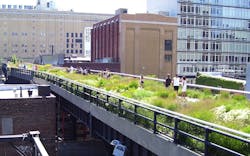The High Line effect: Placemaking as an economic development engine
Last month, developer Related Cos. commissioned Rem Koolhaas’s firm OMA to design its latest project along the High Line elevated park. Koolhaas joins a list of well-known names (among them Zaha Hadid, Renzo Piano, and Robert A.M. Stern) looking to make their mark along the 1.4-mile-long landmark in Chelsea.
Eight years into the transformation of an elevated section of New York Central Railroad’s West Side Line into a public park, the $273 million project is being hailed as a resounding win for the city—and not just for its starchitecture status. Almost overnight, the High Line has become one of New York’s most popular cultural attractions, drawing some five million people in 2014.
It has spurred billions of dollars in economic development activity in Chelsea. In the most dramatic real estate deal to date, Manhattan developer Ziel Feldman last November acquired a 76,425-sf parcel adjacent to the park for a hefty $800 million. Days later, Feldman announced plans for an 800,000-sf mixed-use tower that could fetch as much as $6,000 per sf for luxury condo space—nearly triple the going rate for the area, according to the New York Post.
As big money and eager tourists flock to Chelsea, cities across the globe are starting to take notice. Chicago, Los Angeles, San Francisco, Seoul, Sydney, Toronto, and Washington, D.C., are among the metros currently planning High Line-inspired park projects. Some, like Seoul’s $37 million conversion of a 0.6-mile stretch of elevated motorway, are quite literal adaptations of the concept. Others go off the rails. Here are a few of the more imaginative projects:
• San Francisco’s new Transbay Transit Center, scheduled to open in 2017, will feature a 5.4-acre rooftop park with an amphitheater, water features, restaurant, and gardens that will be easily accessible from the street.
• In Washington, D.C., if all goes as planned, a dilapidated freeway bridge over the Anacostia River will be converted into a lush public park, complete with plazas, lawns, and urban farming plots, as well as space dedicated for the future development of a café and performance venue.
• Just last month, the Hudson River Park Trust gave the green light to a $130 million plan backed by billionaire Barry Diller to build a floating park, called Pier 55, on the Hudson River on Manhattan’s Lower West Side.
The power of placemaking as an economic development engine has been a known phenomenon for well more than a century. In fact, 140 years before the “High Line effect” there was the “Central Park effect.” Its creator, Frederick Law Olmsted, was able to prove through a 17-year study that the values of property surrounding his grand new park grew substantially—by a collective $209 million in 1873 dollars—in the years following its completion. Dozens of other cities across the globe can point to public park projects that have stimulated swift economic development activity.
What differentiates the High Line project—as well as its inspiration, the Coulée verte René-Dumont in Paris, which opened in 1993—is its fresh adaptation of a unique piece of urban infrastructure. The High Line forces urban planners, city officials, and landscape architects alike to rethink traditional urban park models.
Will the High Line’s novelty fade once every city has its version of a gritty urban remake? Maybe. But one thing is a constant: the value of public parks is stronger than ever.

